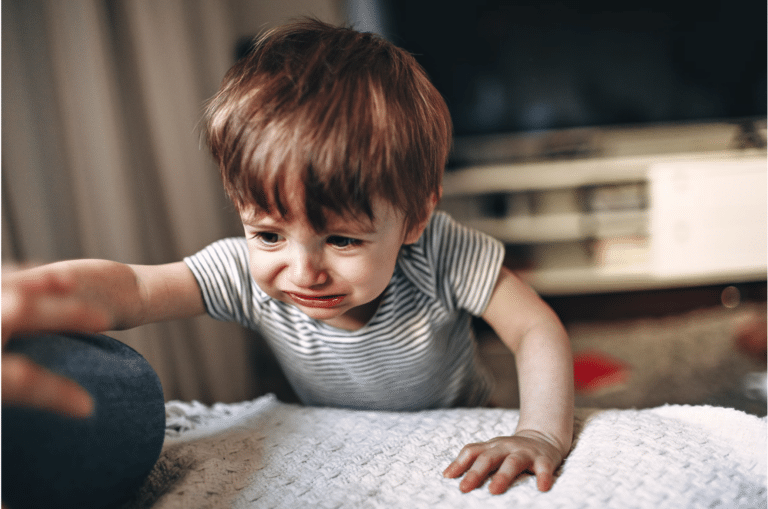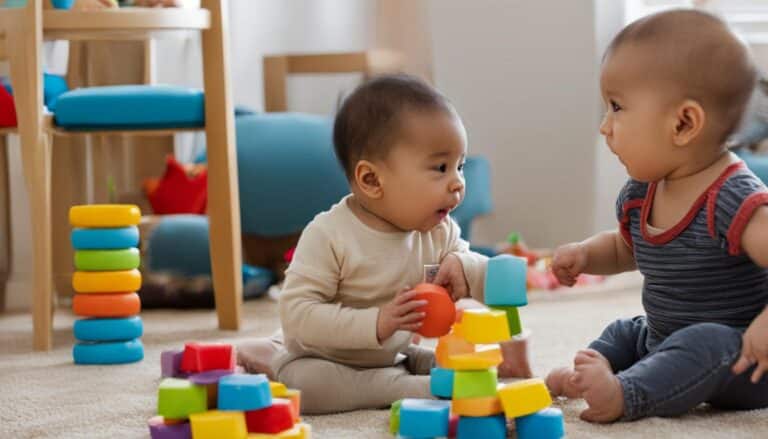Mastering Newborn Sleep: Expert Tips for Peaceful Nights
Having a newborn can be challenging, especially when it comes to sleep. But with expert-approved tips, you can help your baby sleep better and ensure peaceful nights for both of you. In this article, I will explore effective newborn sleep strategies that will help you create a soothing sleep environment, establish a bedtime routine, and understand your baby’s sleep cues. By following these tips, you can navigate through the early months of your child’s life with better sleep and less stress.
Key Takeaways:
- Implementing newborn sleep tips can help your baby sleep better
- Create a soothing sleep environment for your baby
- Establish a consistent bedtime routine
- Recognize your baby’s tired cues to promote healthier sleep
- Follow safe sleep practices to ensure your baby’s well-being

Understanding Newborn Sleep Patterns
Newborns have unique sleep patterns that differ from older infants and adults. It’s important to comprehend these patterns to better manage your baby’s sleep schedule and expectations. Here are some key points to understand about newborn sleep patterns:
Newborn Sleep Duration:
Newborns sleep for shorter periods, usually between 30 minutes to three hours at a time. This is because their tiny stomachs can only hold small amounts of milk, and they need frequent feedings. As a result, their sleep cycles are shorter compared to adults.
REM Sleep:
Newborns spend a considerable amount of time in REM (Rapid Eye Movement) sleep, which is the sleep phase associated with dreaming. REM sleep is crucial for their brain development and overall growth. It’s normal for newborns to have more REM sleep than deep sleep stages.
Adjusting Expectations:
Understanding your baby’s sleep patterns will help you adjust your expectations accordingly. Newborns don’t follow a strict sleep schedule and sleep can be fragmented. It’s essential to be flexible and responsive to your baby’s needs, allowing them to feed, sleep, and wake as they naturally require.
| Age Group | Average Sleep Duration (24 hours) | Number of Sleep Cycles |
|---|---|---|
| Newborn (0-3 months) | 14-17 hours | 7-8 cycles |
| Infant (3-6 months) | 12-15 hours | 6-7 cycles |
Remember, every baby is unique, and sleep patterns can vary. Use these guidelines as a reference, but always pay attention to your baby’s individual cues and needs.
By understanding your newborn’s sleep patterns and adjusting your expectations accordingly, you can ensure better sleep for both you and your baby. In the next sections, we will explore strategies for creating a soothing sleep environment, establishing a bedtime routine, and promoting independent sleep for your little one. Stay tuned!
Creating a Soothing Sleep Environment
When it comes to helping your newborn sleep, creating a soothing sleep environment is key. By setting up the right conditions, you can help your baby feel calm and comfortable, promoting better sleep. Here are some tips for creating a sleep environment that promotes relaxation:
- Use blackout shades: Darken the nursery with blackout shades to create a dark and peaceful atmosphere, which can help your baby sleep better.
- Consider a white noise machine: Mimic the familiar sounds of the womb by using a white noise machine. The gentle hum can drown out external noises and provide a soothing background sound.
- Swaddle your baby: Swaddling can help your baby feel secure and prevent startle reflexes that may disturb their sleep. Use a lightweight, breathable swaddle to ensure your baby stays safe and comfortable.
- Keep the room cool: Maintain a temperature of around 68-72 degrees Fahrenheit in the bedroom. A cooler room can aid in better sleep as it mimics the optimal sleep environment.
By creating a calming sleep environment, you can help your newborn feel secure and relaxed, setting the stage for a peaceful night’s sleep.
Quotes:
“A dark and quiet sleep environment can help newborns establish healthy sleep patterns.” – Sleep Expert
| Benefit | Tip |
|---|---|
| Improved sleep quality | Use blackout shades to create a dark nursery |
| Reduced disruptions | Consider using a white noise machine to drown out external noises |
| Enhanced comfort | Swaddle your baby to provide a sense of security |
| Optimal sleep environment | Keep the room cool, around 68-72 degrees Fahrenheit |
Establishing a Bedtime Routine
Creating a consistent bedtime routine is key to helping your baby develop healthy sleep patterns. A bedtime routine helps signal to your baby that it’s time to wind down and prepare for sleep. By following a consistent schedule, your baby will begin to associate the routine with sleep cues and find it easier to settle down.
The Importance of Consistency
A consistent schedule is essential for establishing a bedtime routine. Babies thrive on predictability, so it’s important to choose a set bedtime and stick to it as closely as possible. This consistent schedule will help regulate your baby’s internal clock and make it easier for them to fall asleep and stay asleep.
When establishing a bedtime routine, start with a soothing activity such as a warm bath or a gentle massage. This helps calm your baby and signals that it’s time to relax. After the calming activity, dim the lights in the room and play soft music or white noise to create a peaceful atmosphere.
Creating a Calm and Relaxing Environment
A calm and relaxing sleep environment can greatly contribute to your baby’s ability to fall asleep easily. Keep the bedroom cool, around 68-72 degrees Fahrenheit, as a slightly cooler temperature helps promote better sleep. Use blackout shades to create a dark and quiet nursery, ensuring minimal light and external noise disturbances.
Consider incorporating a comfort object such as a soft blanket or a favorite stuffed animal into your baby’s bedtime routine. These objects can provide a sense of security and help your baby relax before sleep. However, it’s important to ensure that the object is safe and does not pose any suffocation hazards.
Remember, every baby is different, so it may take some time to find the bedtime routine that works best for your little one. Be patient and consistent, and soon your baby will develop healthy sleep habits and enjoy peaceful nights of restful sleep.
| Benefits of a Bedtime Routine | How to Establish a Bedtime Routine |
|---|---|
|
|
Recognizing Tired Cues
Recognizing tired cues in your baby is essential for helping them get the sleep they need. By understanding the signs that indicate sleepiness, you can respond promptly and prevent overtiredness, which can make it more challenging for your baby to fall asleep and stay asleep.
Some common tired cues to look out for include zoning out or staring into space, avoiding stimulation or becoming disinterested in their surroundings, rubbing their eyes, and getting fussy or irritable. These signs often indicate that your baby is ready for sleep and should be put down for a nap or bedtime.
It’s important to remember that every baby is different, and they may exhibit their tired cues in unique ways. By spending time observing your baby’s behavior, you can learn to recognize their individual signs of sleepiness. This will enable you to establish a sleep routine that aligns with their natural sleep patterns, promoting healthier and more restful sleep for your little one.
Common Tired Cues:
- Zoning out or staring into space
- Avoiding stimulation or becoming disinterested
- Eye rubbing
- Fussiness or irritability
By staying attuned to your baby’s tired cues, you can create a sleep-friendly environment and establish a consistent sleep routine that supports their natural sleep needs. This will contribute to better overall sleep quality for your baby, leading to happier, more well-rested days for both of you.
| Tired Cue | Description |
|---|---|
| Zoning out or staring into space | Baby appears distant and unfocused, indicating fatigue |
| Avoiding stimulation or becoming disinterested | Baby turns away from toys or loses interest in activities |
| Eye rubbing | Baby rubs their eyes, a common sign of sleepiness |
| Fussiness or irritability | Baby becomes cranky or easily agitated |
Managing Daytime Wake Windows
Understanding and managing your baby’s wake windows is crucial for establishing a healthy sleep schedule. Wake windows refer to the length of time your baby can comfortably stay awake between naps before becoming overtired. By observing your baby’s cues and following appropriate wake windows, you can promote better sleep quality and prevent unnecessary fussiness.
The Relationship Between Age and Wake Windows
The length of wake windows varies based on your baby’s age. Newborns typically have shorter wake windows of about 45-60 minutes, while older infants can handle longer wake windows of up to 3-4 hours. It’s important to be aware of these age-related differences and adjust your baby’s sleep schedule accordingly.
Here’s a general guide to wake windows based on age:
| Age | Wake Window Duration |
|---|---|
| Newborn (0-2 months) | 45-60 minutes |
| 3-4 months | 1.5-2.5 hours |
| 5-6 months | 2-3 hours |
| 7-9 months | 2.5-4 hours |
| 10-12 months | 3-4 hours |
Observing Your Baby’s Cues
Every baby is unique, and it’s important to pay attention to their individual cues to determine when they are ready for sleep. Look for signs of sleepiness, such as yawning, rubbing their eyes, or becoming fussy. By responding to these cues promptly and putting your baby down for a nap or bedtime at the right time, you can prevent overtiredness and promote healthier sleep patterns.
Remember that these wake window guidelines are not set in stone and can vary from baby to baby. It’s essential to adapt to your baby’s needs and schedule accordingly, allowing for flexibility as they grow and develop.
Section 7: Promoting Independent Sleep
When it comes to newborn sleep, promoting independent sleep is a key goal for both parents and babies. Teaching your baby to fall asleep independently not only helps them develop self-soothing skills but also promotes better sleep quality for the whole family. Here are some strategies to encourage independent sleep:
Creating a Sleep-Friendly Environment
A soothing sleep environment plays a crucial role in promoting independent sleep. Make sure your baby’s nursery is dark, quiet, and free from distractions. Consider using blackout shades to block out any light and a white noise machine to provide a consistent, soothing sound. These elements can help create a calming atmosphere that encourages your baby to settle down and sleep on their own.
Establishing a Bedtime Routine
A consistent bedtime routine is an essential part of promoting independent sleep. By following the same sequence of activities every night, such as a bath, reading a story, or cuddling, your baby will come to associate these actions with sleep. This familiarity helps them feel secure and ready to fall asleep on their own.
| Bedtime Routine Example |
|---|
| 1. Warm bath |
| 2. Gentle massage |
| 3. Storytime |
| 4. Dim the lights |
Implementing Sleep Training Techniques
Sleep training can be an effective way to help your baby develop the skills needed for independent sleep. Gradual methods, such as the “Fading” or “Cry It Out” technique, can help your baby learn to soothe themselves and fall back to sleep during night awakenings. It’s important to approach sleep training with patience, consistency, and support for your baby’s emotional needs.
“Teaching your baby to fall asleep independently is a valuable skill that promotes better sleep for both of you.”
Promoting independent sleep requires patience and consistency. Remember that every baby is different, and it may take time to find the right approach that works for your little one. By prioritizing a sleep-friendly environment, establishing a bedtime routine, and implementing sleep training techniques, you can help your baby develop healthy sleep habits and promote independent sleep.
Dealing with Night Wakings
Night wakings are a common occurrence for newborns and infants, and finding effective soothing strategies can help both you and your baby get the rest you need. Here are some techniques to help manage night wakings and promote better sleep:
- Offer comfort and reassurance: When your baby wakes up at night, try gentle rocking, soothing shushing sounds, or offering a pacifier to provide comfort and help them settle back to sleep. Responding to their needs promptly can help them feel secure and supported.
- Create a soothing environment: Ensure the bedroom is dark, quiet, and at a comfortable temperature. Consider using a white noise machine to provide a soothing background sound that mimics the womb. These conditions can help your baby feel calm and relaxed, making it easier for them to fall back asleep.
It’s important to note that babies may go through sleep regressions, temporary disruptions in their sleep patterns, during certain developmental stages. During these periods, it may be necessary to provide extra reassurance and adjust your soothing strategies accordingly. Remember to remain patient and consistent in your approach, as your baby’s sleep patterns will likely improve over time.
“Sleep regressions are a natural part of your baby’s development. By providing comfort and reassurance, you can help them navigate these temporary disruptions and establish healthier sleep patterns.” – Sleep Expert
Always consult with your pediatrician if you have concerns or questions about your baby’s sleep patterns. They can provide personalized guidance based on your baby’s individual needs and ensure that you are implementing safe sleep practices.
| Soothing Strategies | Effectiveness |
|---|---|
| Gentle rocking | Provides comfort and relaxation |
| Soothing shushing sounds | Creates a calming environment |
| Offering a pacifier | Provides a soothing sucking sensation |
| White noise machine | Mimics womb-like sounds for better sleep |
Safe Sleep Practices
Ensuring a safe sleeping environment is paramount for your newborn sleep tips well-being. By following these safe sleep practices, you can reduce the risk of Sudden Infant Death Syndrome (SIDS) and create a secure sleeping space for your little one.
Back to Sleep
Place your baby on their back to sleep, as this is the safest sleep position. The back sleeping position helps reduce the risk of SIDS and allows for optimal breathing. Avoid placing your baby on their side or stomach to sleep.
Use a Firm Mattress
Provide your baby with a firm and flat sleep surface. A crib mattress that is firm and snugly fits the crib is recommended. Avoid using soft mattresses, waterbeds, or other cushioned surfaces, as they can increase the risk of suffocation.
Avoid Loose Bedding and Pillows
Keep the crib free from loose bedding, blankets, pillows, stuffed animals, or other soft objects. These items can pose a suffocation hazard and increase the risk of SIDS. Instead, dress your baby in a sleep sack or a wearable blanket for warmth.
Optimal Room Temperature
Ensure the room is kept at a comfortable temperature between 68-72 degrees Fahrenheit (20-22 degrees Celsius). Avoid overheating your baby by dressing them in light and breathable sleepwear. Use a baby monitor to keep an eye on the room temperature if necessary.
| Sleep Safety Checklist |
|---|
| Place your baby on their back to sleep |
| Use a firm mattress that fits the crib |
| Avoid loose bedding, blankets, and pillows in the crib |
| Keep the room at a comfortable temperature |
By following these safe newborn sleep tips practices, you can provide a secure sleeping environment for your baby. Always remember that safe sleep is essential for your baby’s well-being and reduces the risk of SIDS. Incorporate these practices into your daily routine to ensure your baby sleeps soundly and safely.
Conclusion
After exploring effective strategies for newborn sleep, it’s clear that creating a soothing sleep environment, establishing a bedtime routine, and recognizing tired cues are key steps in promoting healthy sleep habits for your baby. By following these newborn sleep tips, you can navigate the early months with better sleep and less stress.
Additionally, implementing safe sleep practices and promoting independent sleep can contribute to better sleep quality for both your baby and yourself. Remember to prioritize your baby’s safety by following recommended guidelines for newborn sleep tips, such as placing them on their back and removing any loose bedding or pillows from their crib.
Lastly, it’s important to remember that every baby is different and finding what works best for your little one may take time. Stay patient, consistent, and responsive to your baby’s needs throughout this journey. By doing so, you can help your baby establish healthy sleep habits and ensure peaceful nights for both of you.
FAQ
What are some effective newborn sleep strategies?
Creating a soothing sleep environment, establishing a bedtime routine, and recognizing tired cues are effective strategies for newborn sleep.
How long do newborns sleep at a time?
Newborns sleep for shorter periods, usually 30 minutes to three hours at a time.
How can I create a soothing sleep environment for my newborn?
You can create a soothing sleep environment by using blackout shades, a white noise machine, and swaddling your baby.
What should I include in a bedtime routine for my newborn?
A bedtime routine for your newborn can include a soothing bath, a story or gentle massage, dimming the lights, and playing soft music.
How can I recognize tired cues in my baby?
Tired cues in babies can include zoning out, avoiding stimulation, rubbing their eyes, or becoming fussy.
What are wake windows?
Wake windows refer to the length of time a baby can comfortably stay awake between naps. They vary based on age.
How can I promote independent sleep in my baby?
You can promote independent sleep by encouraging self-soothing techniques and gradually reducing sleep associations.
How can I deal with night wakings?
Gentle rocking, shushing, or offering a pacifier can help soothe your baby during night wakings. Be patient and consistent in your approach.
What safe sleep practices should I follow?
Safe sleep practices include placing your baby on their back to sleep, using a firm mattress, and keeping the room at a comfortable temperature.
What are some tips for navigating newborn sleep?
Prioritize creating a soothing sleep environment, following a consistent bedtime routine, and recognizing your baby’s tired cues. Implement safe sleep practices and promote independent sleep.







